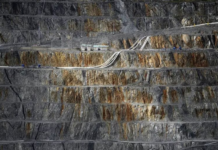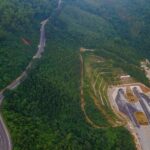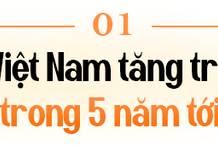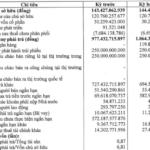
The construction of a tunnel under the Dong Nai River, instead of the Cat Lai Bridge, has been proposed by Mr. Vo Tan Duc, Chairman of the People’s Committee of Dong Nai Province. There are several reasons for this proposal.
According to the Chairman, the planned location for the Cat Lai Bridge is close to the Cat Lai, Dong Nai, and Binh Duong ports, so the bridge needs to have a high clearance to allow large cargo ships to enter and exit the ports.
Designing a high clearance bridge would require long approach roads, resulting in a larger area of land acquisition and clearance on both the Ho Chi Minh City and Dong Nai sides, as well as increased investment costs.

The area still relies on the ferry. After taking the ferry, people from Ho Chi Minh City can reach Ba Ria-Vung Tau province.
Dong Nai’s proposal to build a tunnel connecting Ho Chi Minh City instead of a bridge aims to minimize land clearance and reduce project investment costs.
Additionally, the tunnel option will preserve the aesthetics of both banks of the Dong Nai River and will not impact the operations of Cat Lai Port.
The People’s Committee of Dong Nai Province has worked with Fecon Joint Stock Company and Shanghai Tunnel Engineering Co., Ltd. (STEC). Fecon and its partner have proposed the idea of constructing a tunnel under the Dong Nai River.
According to the initial research by Fecon, building a tunnel will help overcome challenges related to land clearance and minimize social impacts on the residential areas within the planning zone.
There are two proposed options. The first option is to build a tunnel longer than 2.3 km, with 8 lanes (4 lanes per tunnel) and a designed speed of 80 km/h. The second option has a smaller scale with 6 lanes, including 3 lanes per tunnel, and a total length of over 1.7 km.
Based on the research, the most cost-effective and quickest option for constructing a tunnel instead of the Cat Lai Bridge is estimated to cost VND 9,000-10,000 billion, and the construction time is expected to be less than 2 years.
Nhon Trach District in Dong Nai is just across the Dong Nai River from Thu Duc City in Ho Chi Minh City. Currently, the shortest route from Thu Duc City to Nhon Trach District is by taking the Cat Lai ferry. The road connecting to the ferry terminal on the Dong Nai side, in Phu Huu commune, is very narrow and often congested during holidays.
The proposed Cat Lai tunnel has several advantages
Recently, Dr. Pham Viet Thuan, Director of the Institute of Economics, Finance, and Environment in Ho Chi Minh City, shared with VnExpress that this solution aligns with the logistics development trend in the region, as larger vessels are increasingly used for transportation.
He also mentioned that about 20 years ago, riverboats had a capacity of around 500 tons, but now they can carry 2,000-5,000 tons. With the growing demand for water transport along the Soai Rap and Dong Nai rivers to and from the port clusters in the region, Dr. Thuan believes that building a tunnel is a long-term strategy to develop water transport infrastructure. On the other hand, constructing a bridge would require a high clearance to accommodate large ships, at least 45 meters similar to the Phu My Bridge.
Additionally, Dr. Thuan pointed out that a tunnel would minimize the impact on the river view and landscape, as well as reduce compensation and land clearance compared to a bridge option. A high clearance bridge would require long approach roads, resulting in a larger area of land acquisition and potential disruption to established residential areas.

The Saigon River Tunnel (Thu Thiem Tunnel) is currently the only tunnel crossing the river in Vietnam.
However, the expert acknowledged that the challenge of the tunnel option lies in its higher investment cost compared to a bridge, and the construction process would require complex technical solutions. “But in the long run,” he said, “the tunnel will bring better economic and social benefits as the area is expected to experience significant growth in water-based transportation and tourism.”
The Saigon River Tunnel (Thu Thiem Tunnel) is currently the only tunnel crossing the river in Vietnam. It is also one of the projects that contribute to connecting Thu Thiem Peninsula with the Ho Chi Minh City center.
The Saigon River Tunnel (Thu Thiem Tunnel) was inaugurated in 2011 after 7 years of construction. The project received nearly VND 2 billion in investment support from Japanese ODA funds. The tunnel was constructed using the longest cast-in-place method in Southeast Asia.
According to the design specifications, the tunnel is over 33 meters wide and nearly 9 meters high. With a total length of almost 1,500 meters, the tunnel is divided into three main sections: the Ho Chi Minh City approach tunnel (585 meters long), the Thu Thiem approach tunnel (535 meters long), and the immersed tunnel (370 meters long).
The Richest Region in Vietnam is Getting a Massive River Tunnel, Connecting Two of the Country’s Most Prosperous Provinces
The Prime Minister has approved plans to construct a tunnel under the river in this region. This ambitious project will revolutionize transportation and connectivity, providing a seamless and efficient link for locals and businesses alike. With a state-of-the-art design, the tunnel promises to be a safe and convenient passage, offering a unique and innovative solution to the region’s transportation needs. This forward-thinking decision underscores the government’s commitment to investing in critical infrastructure and fostering economic growth and development in the area.
The $173 Million Mountain Tunnel: A Testament to Vietnamese Engineering Excellence
In just 6 minutes, travelers can now journey through the Cu Mong Pass connecting the provinces of Binh Dinh and Phu Yen. This new road tunnel, measuring over 7km in length, offers a safer and significantly faster alternative to the treacherous mountain pass, which previously took up to 30 minutes to traverse.
Breakthrough Tunneling: The Deo Ca Pass Project’s Rapid Construction Secrets Unveiled
The 355-meter-long Tunnel No. 2, belonging to the XL01 contract package of the Khe Net Pass Railway Improvement Project, has officially been excavated (Image: Quang Binh Province’s Electronic Information Portal).













































